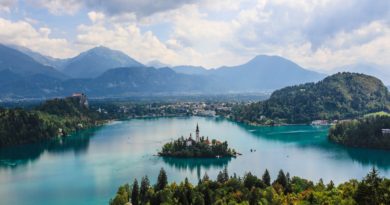NCC: Land Lines – Scaling-up restoration
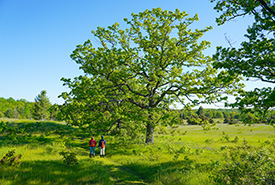
Hazel Bird Nature Reserve, ON (Photo Chelsea Marcantonio/NCC Staff)
“We can do something big here.”
That was my thought in spring 2011 when I looked across the rolling, sandy hills of what would become the Hazel Bird Nature Reserve in Ontario. At that time, I had been with the Nature Conservancy of Canada (NCC) for several years, and we identified the property as a promising conservation project. Although it was over-run by introduced Scots pine, knapweed and other invasive species, it still had remnants of a tall grass prairie landscape.
NCC purchased the property, and immediately kick-started years of strategic and relentless restoration work by NCC staff and volunteers, with techniques evolving over time. The tall grasses, native woody plants and wildflowers have since returned and expanded, along with the wildlife that depends on them. While the work is ongoing, nature is slowly and quietly telling us of our success, with the return of grassland and savannah-dependent species like upland sandpiper and the endangered mottled duskywing.
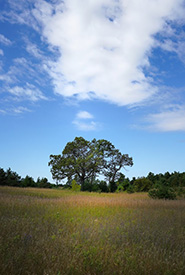
Hazel Bird Nature Reserve, ON (Photo Chelsea Marcantonio/NCC Staff)
Hazel Bird was acquired under the Rice Lakes Natural Area Conservation Plan, a landscape-scale restoration project rooted in collaboration. NCC developed and shared our vision to restore thousands of hectares of this globally rare tall grass prairie and oak savannah landscape. Since 2002, NCC has helped lead the Rice Lake Plains Partnership (RLPP) — a coalition of private landowners, Alderville First Nation, conservation groups and government agencies that have banded together to protect and restore the Rice Lake Plains.
NCC aims to identify and improve the fragmented historic tallgrass ecosystems in the area, and to bring communities together to help make this happen. In these ways, Rice Lake Plains embodies the kind of big thinking and collective action needed in restoration to face the dual crises of climate change and biodiversity loss.
On-the-ground response to a global challenge
Target 2 of the Kunming-Montreal Global Biodiversity Framework is to restore 30 per cent of all degraded ecosystems, ensuring that by 2030, at least 30 per cent of areas of degraded terrestrial, inland water, and coastal and marine ecosystems are under effective restoration.
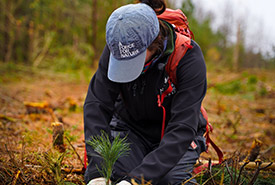
Ali Giroux, former conservation biology coordinator, planting native trees in an area where an invasive Scots pine plantation was removed, Hazel Bird Nature Reserve, ON (Photo by Chelsea Marcantonio/NCC staff)
At NCC, restoration is a key tool we are using to halt or reverse threats to biodiversity loss and meet global conservation goals. And there is urgency: we are in the middle of the United Nations Decade on Ecosystem Restoration (2021–2030), a call for the world to take action on the degradation of ecosystems.
Healthy ecosystems support biodiversity and perform essential services for all of us: filtering water, removing pollution and storing carbon. NCC has created a Restoration Framework to guide how we care for ecosystems in support of a thriving world for nature and people. The framework’s guiding principles aim to ensure effective, efficient, engaging and equitable ecological restoration practices.
Habitat restoration in the Rice Lake Plains is just one example of NCC’s shifting approach conservation. We are thinking beyond the property-level: by focusing on larger landscapes, NCC can address ecological processes and threats that operate at broader scales. Other large, multi-partner projects include the Prairie Grasslands Action Plan and collaborative invasive phragmites control in southern Ontario. The approach aims to create connected and resilient ecosystems through the exemplary stewardship of NCC projects and the strategic support of conservation work with partners and private landowners. We need to think beyond individual NCC projects and consider the broader landscape to ensure long-term ecological health.
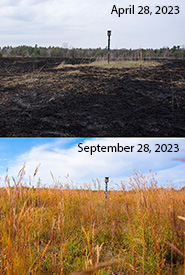
Before and after prescribed burn at Hazel Bird, ON (Photo by NCC)
Using the right tool in the right location is an important component of restoration planning. It can mean, in some cases, targeted herbicide applications to manage invasive plants. NCC staff are trained to apply herbicide and best practices are followed to use only at levels approved for the particular invasive species in that area. NCC uses prescribed burning on grassland and savannah habitats, including at Rice Lake Plains, to promote the growth and return of native species. Through an evidence-based approach, we can work efficiently to make a difference for these ecosystems.
The science of hope
For restoration work, you must be persistent and patient. It can take years — in some cases a decade or more — for the hard work to pay off. Once a natural habitat is re-established at a site, it still requires investment to ensure its success. It’s vital that we look ahead to the future and make sure we have the resources to follow through with restoration projects beyond the initial phase.
A colleague once sagely said to me that restoration work is “the science of hope.” It brings me great joy and I know it brings hope when our staff are out in the field — the ones toiling away on properties across the country — observe a species like the upland sandpiper or mottled duskywing that has returned to restored habitat. And I trust that these special, exemplary restored sites will give others hope as well. We can make a difference for the planet.
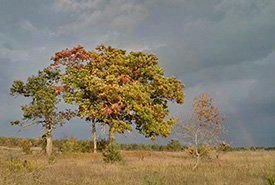
Hazel Bird Nature Reserve, ON (Photo by Mark Stabb/NCC staff)
It’s not only the dedication of NCC’s field staff that makes this possible. We also learn from Indigenous communities, and NCC staff have been fortunate to have had friends, mentors and allies in Alderville First Nation, whose Alderville Black Oak Savanna project has been an inspiration and guiding light for us since day one. Conservation partners, volunteers, donors, industry and government quite literally fuel the fires of collaboration that is vital to the success of these restoration projects.
It’s may not be pristine, but when I go back to the lookout at Hazel Bird I see a landscape that’s transformed from a sea of Scots pine and knapweed, to a healthy tall grass prairie and oak savannah. I feel heartened, grateful and hopeful. While the work continues, I can see the change that has taken place. Together, we did something big.



